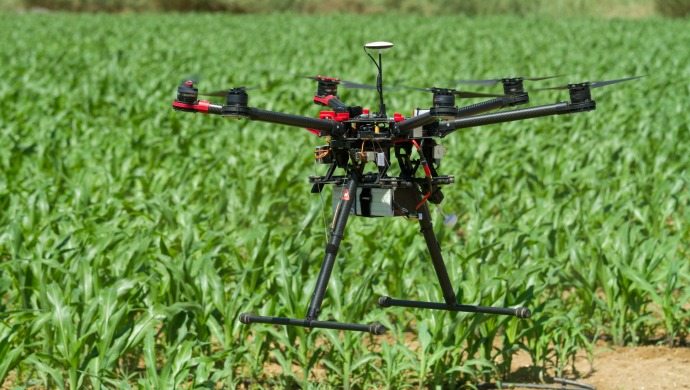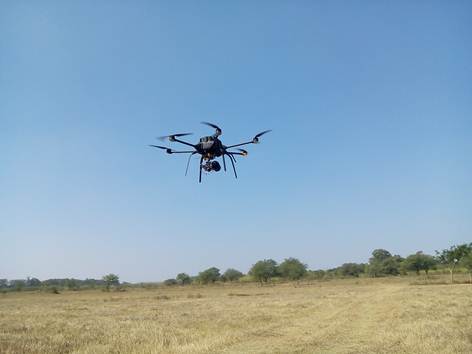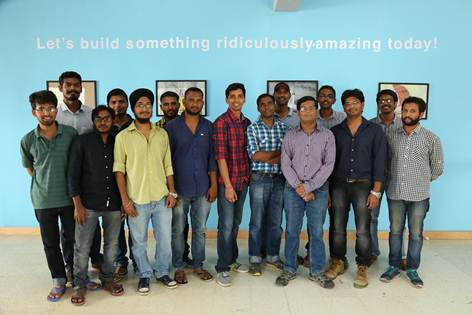Beyond recreational use: A group of four IITians have come up with drones that can be used for topography surveying, precision agriculture, and industrial inspections

While pursuing graduation at the Indian Institute of Technology (Kanpur), Nikhil Upadhye, Suhas Banshiwala and Vipul Singh got a rare opportunity to represent their college at the SAE design competition organised by the NASA in the US.
The trio, each attached to aero-modelling and robotics in one way or another, were asked to design an unmanned aerial vehicle (UAV), or drone, that weighed least and could lift maximum payload.
During their visit, they noticed that there was a huge awareness about aerial vehicles in the US, and that people used them for various recreational purposes. Back in India, their home country, drones were still an alien concept to many, and most people had not even seen one in their lives. Even the word “drone” was not so familiar.
“We immediately sensed an opportunity in this space, and we got together to brainstorm ideas about drones. That led to the birth of the startup Aarav Unmanned Systems (AUS),” Co-founder and Chief Business Development Officer Singh told e27.
After a lot of brainstorming on possibilities v/s fantasies and a lot of technical scribbles, the trio realised that utilisation of UAVs for engineering applications is the future, and its applications are not restricted to recreational usage or mere photography. “This was the point when we started working on building technology for 3D mapping and GIS surveying which further extended to industrial inspections and precision agriculture,” added Singh.
After roping in their friend Yeshwanth Reddy as a co-founder, the company began to work towards its goal to become one of the top names in the Indian drones space.
In Photos: Drone-making at Global Inovasi Informasi Indonesia’s factory
Currently, AUS is a team of 16 designers, artists, developers, and engineers from premier educations institutions in India. Singh claims AUS’s drones provide high-value engineering solutions to enterprises across GIS surveying/mapping, industrial inspection and precision agriculture (satellite farming). In his own words, AUS is “10x faster and generates much richer data, helping to create insightful analytics so that businesses take well-informed decisions.”
Since its inception three years ago, the startup has been tirelessly working on drone intelligence, hardware optimisation and design innovation. Singh says that it has served enterprises across various verticals even before the final product has come out. It has currently set its eyes on the global market.
The company has started taking orders for a limited quantity batch of MVPs from early-stage partners. These units are expected to be delivered by mid-March. “Our products will be commercially launched by July 2017. This depends lot many factors and availability of resources which we are working out. We are having optimistic expectations and fingers crossed,” Singh noted.
AUS’s solutions are mainly catering to three industries:

- Topography surveying: Mining, roads and railway development, urban planning, asset management, land records, large construction sites, and stockpile/quarry management;
- Industrial inspections: Solar power plants, power transmission lines, telecom towers and chimneys; and
- Precision agriculture: Crop stress mapping, health assessment, and Chlorophyll mapping.
Although he refused to share the pricing details of AUS drones, Singh said theirs are two times more affordable than the comparable solutions in this segment which are coming from countries like Germany, US, France, and Switzerland.
While India is still a slow-paced market when it comes to the development and usage of drones, there are a handful of companies striving to put the country on the global drones radar. Bangalore-based Skylark Drones is one among them and is one of the oldest. Singh, however, said that AUS’s products are much advanced.
“Unlike many other global products, our solution is not just about the hardware but it comes with a professionally integrated ecosystem of data processing and data analytics. This has given us the very unique superpower of not just delivering data but actionable information to the enterprises directly,” Singh explained. “Ventures like Skylark target the local markets and use solutions/technology like ours to cater to their clients by collecting reasonable data for them on case to case basis. Such ventures are one of our customer segments worldwide and key part of the entire solution chain,” Singh said.
Policies drive drones out of India’s airspace
The use of drones is a highly regulated industry in India. Given its long hostile relationship with its neighbours China and Pakistan, India cannot put its security at risk by letting UAVs fly freely on its airspace. While it was supposed to come up with policies related to drones, things have not made much headway yet.
Also Read: How drones can help Singapore be the world’s first Smart Nation
“It was motivating when the Director General of Civil Aviation (DGCA) realised the need of regulations and guidelines for drone operations in India a couple of years ago. But things are moving pathetically slow and in very impractical direction. Meanwhile in these two years, China increased its drone exports from US$200 million to approximately US$1 billion, gave out more than 5,000 drone pilot licenses, and even started using drones for their agriculture,” Singh expressed his disappointment with the government.

The AUS team
“Struggle with policies should be the last thing which should come our way specially when Prime Minister Narendra Modi is so determined to ‘Startup India’ and ‘Make in India’ initiatives,” he added.
He feels that such scenarios are not liked by many investors and will lead to slow or no growth of the industry. This ultimately leads to late availability of technology to end-users and hence technical backwardness from their global counterparts and direct impact on a nation’s productivity.
“We were fortunate that we understood all this at the very early-stages and started working on a globally competitive product. So far the regulations are more concerned with operations and does not restrict on production. We will focus on global sales to avoid any impact on our growth due to such slow progress on framing the guidelines,” Singh sounded optimistic.
However, if things are not improving, AUS will shift its base to some other country, warned Singh. “We never wanted to do this, but if this situation persists, we might think of shifting our base to some other country. We can’t let our vision and efforts deliver less because of some policy paralysis in India.”
The foreign threat
It is a known fact that most of the world’s drones are made in countries like China, Germany and Switzerland. Despite that, the commercial drones industry is still at its dawn. “All these three countries definitely have fairly advanced innovation and production ecosystem but India is nowhere less when it comes to very smart and talented people. We believe consistent innovation of technology and business strategy is key to success. Our wisdom is not limited to operate only from India or in India. We see a united world and as time comes, depending on our needs we will utilise all the required global resources,” Singh added.
Drones for e-commerce delivery
Drones for logistics are going to be one of the large markets in the near future, said Singh. This is going to increase the efficiency and reach of e-commerce companies. Large players like Amazon and DHL have already started their initiatives in this direction. “We do have plans to work on solutions related to this application once we are done with our current goal and find suitable resources and partners to do so,” Singh noted.
AUS is one of the top 10 finalists of Qualcomm Design in India Challenge (QDIC) 2015. He said that the future of drones will be more connected, highly integrated and power efficient platforms — very similar to what is happening in the mobile phone market. “Qualcomm has been the leader when it comes to such solutions. We feel solutions at Qualcomm have suitable features to be used with drones and IoT devices.”
The drone startup has got its first round of funding in February 2016 from StartupXseed Ventures, 3ONE4 Capital, Valpro Capital, Ashok Atluri and Sanjay Jesrani. It now looks to raise another round very soon for team expansion, production, and reaching out to the global market.
How do you face tough times in your startup life. “Well, focus on what’s needed and ignore what’s not. Put earphones, listen to Pink Floyd and keep doing the work,” Singh signed off.
Indian markets are already dominated by Chinese drones. Cheap drones meant for recreational purposes regularly make way into the markets in Bangalore and other parts of the country. However, enterprise-oriented drones are still out of India’s radar. Companies like AUV and Skylark are betting big on this segment. If regulations are relaxed, India will see thousands of drones hovering on its airspace in the near future.
—-
Lead Image Credit: rustsleeps / 123RF Stock Photo
The post Despite tight regulations, this startup looks to fly drones over Indian airspace soon appeared first on e27.